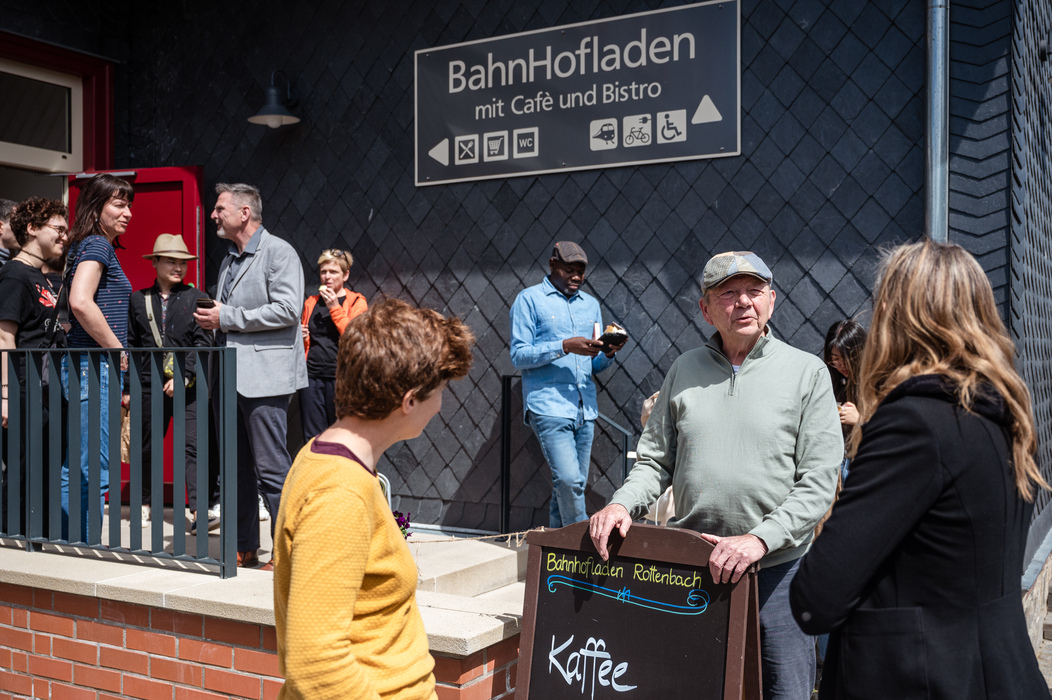Rottenbach Train Station
⸺ A Gateway to Schwarzatal
The train service hopefully still operates, but the station building stands empty: a typical scenario in rural areas. This was also the case in the town of Königsee, situated on the outskirts of Schwarzatal, historically shaped by tourism, agriculture, and medium-sized enterprises. The station in the district of Rottenbach served as a crucial transportation hub, welcoming many travelers.
Subsequently, the municipality purchased the station building from the Deutsche Bahn, rescuing it from decay. The then-mayor and the local residents collectively contemplated: What to do with this former gem? Given the closures of various public facilities in Rottenbach, such as schools, eateries, and shops since the 1990s, 40 willing individuals established a cooperative in 2015 to independently establish a store within the station. Additionally, they aimed to enhance the station's connectivity to public transportation. These aspirations aligned with the project call "Zukunft StadtLand!" by IBA Thuringia in 2014, which sought to support construction projects that prioritized public welfare. Since 2015, IBA has been collaborating with the town and the cooperative on this project.
Before the commitment of the municipality and stakeholders could yield results, the station and its forecourt required structural improvements. Initially, the town of Königsee, alongside IBA Thuringia and the LEADER Aktionsgruppe Saalfeld-Rudolstadt e. V., commissioned a conceptual study for the new transport interchange and forecourt. The design STADTLAND:INSELN by atelier le balto was chosen as the preferred option. Subsequently, in 2017, the station forecourt underwent renovations and once again serves as a transportation hub for buses, trains, cars, and bicycles. The design incorporated regional traditions: Four landscape islands break up the asphalt, picket fences enclose farm gardens maintained by the cooperative.
The monument-conserving restoration of the building commenced in 2016 by the construction office lehniger from Gotha. In 2017, a student architecture competition held by the Bauhaus University Weimar and the University of Applied Sciences in Leipzig delivered initial ideas for the design of the planned railway station shop. These concepts were revised multiple times before being realized. K3L Architecture + Design, a young firm from Leipzig established by students after the competition, collaborated with the architecture and engineering office Lindig-Herbst-Lichtenheld from Rudolstadt on the implementation. Among other tasks, numerous fixtures and suspended ceilings were removed, small windows were replaced with floor-to-ceiling ones, and shelves, sales counters, and other interior elements were custom designed and built for the shop.
What makes the shop special is its flexible use for sales or as a meeting point for citizens. Numerous events take place here throughout the year, including on the forecourt, which is suitable for markets during the summer. However, the project is not completed yet. The entire area of Rottenbach Station will receive a small multifunctional wooden building designed by Atelier ST from Leipzig in collaboration with the regional construction office Baumann. It will serve as a community center. The small wooden house is meant to be simple and familiar, naturally integrating into the station square and its surroundings.
Residents, the cooperative, and travelers all appreciate their new meeting and starting point into the Schwarzatal. The station has become a gem, the train station shop is modern, and the station forecourt with its landscaped islands reflects the regional character. This project creates added value for the entire summer resort.
Ort
Bahnhof Rottenbach
Am Bahnhof
07426 Königsee
Projekt sponsor
Cooperation partner
Financial support
- Bundesanstalt für Landwirtschaft und Ernährung: Bundeprogramm Ländliche Entwicklung – Regionalität und Mehrfunktionshäuser
- LEADER, Europäische Union, Freistaat Thüringen, LEADER Aktionsgruppe Saalfeld-Rudolstadt e. V.
- Thüringer Ministerium für Infrastruktur und Landwirtschaft, Städtebauförderung
- Thüringer Landesamt für Bau und Verkehr, Förderung von Investitionen im öffentlichen Personennahverkehr
- Design and realisation of transport interchange and surrounding design: atelier le balto, Berlin
- Renovation of railway station building: baubüro lehniger, Gotha
- Design and structural realisation of the station shop: Architektur- und Ingenieurbüro Lindig | Herbst | Lichtenheld, Rudolstadt, K3L Architektur + Design, Leipzig
- Design and structural realisation of multifunctional building: Atelier ST, Leipzig, Baubüro Baumann, Königsee










